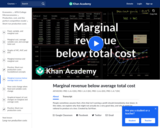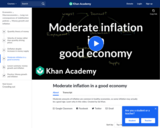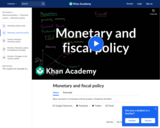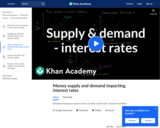
Introduction to the marginal propensity to consume and the multiplier
- Subject:
- Business and Marketing Education
- Finance
- Material Type:
- Lesson
- Provider:
- Khan Academy
- Author:
- Rishi Desai
- Date Added:
- 09/22/2013

Introduction to the marginal propensity to consume and the multiplier

Why it is rational to produce at a loss

Thinking about a rational quantity of juice to produce

Marginal utility and marginal benefit. How you would spend $5 on chocolate and fruit

Market versus book value of equity

Equilibrium price and quantity for supply and demand

Market value of assets.

This video is from the Khan Academy subject of Economics and Finance on the topic of Finance and capital markets and it covers Marriage penalty.

This video is from the Khan Academy subject of Economics and Finance on the topic of Finance and capital markets and it covers Married taxes clarification.

How a minimum wage might effect the labor market

Why there tends to be moderate inflation during good economies

Basic mechanics of monetary and fiscal policy

Examples showing how various factors can affect interest rates

The financial crisis of 2007-8 has already revolutionized institutions, markets, and regulation. Wright's Money and Banking V 2.0 captures those revolutionary changes and packages them in a way that engages undergraduates enrolled in Money and Banking and Financial Institutions and Markets courses.
Minimal mathematics, accessible language, and a student-oriented tone ease readers into complex subjects like money, interest rates, banking, asymmetric information, financial crises and regulation, monetary policy, monetary theory, and other standard topics. Numerous short cases, called "Stop and Think" boxes, promote internalization over memorization. Exercise drills ensure basic skills competency where appropriate. Short, snappy sections that begin with a framing question enhance readability and encourage assignment completion.
The 2.0 version of this text boasts substantive revisions (additions, deletions, rearrangements) of almost every chapter based on the suggestions of many Money and Banking instructors.

Why it is hard for a monopolisitc competitor to make economic profit in the long run

Looking a bit deeper at why elasticity changes despite having a linear demand curve

What happens when a good is not finished in a period

Public vs. Private Equity. Why people buy equity to begin with.

Looking more closely at the definition of Nash Equilibrium

Clarification on the relationship between total revenue and elasticity